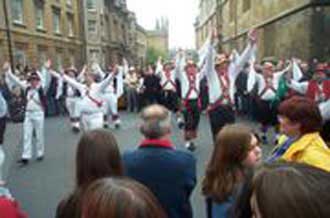Morris名稱的來源,據(jù)說因為早期莫里斯舞者多為受當(dāng)時基督教排斥的異教徒,為了避免受到宗教迫害所以把臉涂黑,而當(dāng)時最受注目的一個黑臉舞者是莫爾人(Moors),所以后來人們稱他們的舞蹈叫莫里斯舞。不過,也有另一派說法是來自Morisco這個字,泛指十五、六世紀(jì)時歐洲地區(qū)鄉(xiāng)村地區(qū)的舞蹈。

A morris dance is a form of English folk dance. It is based on rhythmic stepping and the execution of choreographed figures by a group of dancers. Implements such as swords, pipes, and handkerchiefs may also be wielded by the dancers.
Cotswold morris with handkerchiefs There are English records mentioning the morris dance dating back to 1448, though dances with similar names and some similar features are mentioned in Renaissance documents in France, Italy, and Spain.
The origins of the term are uncertain, but one of the most widely accepted theories is that the term was "moorish dance" and "Moresco" (in Spain), which eventually became "morris dance". Another, perhaps simpler, explanation is that "Morris" comes from the Latin "Mores", meaning "a custom". This is consistent with the word (with various archaic spellings) sometimes being used to describe some other folk customs such as folk plays.
In the modern day, it is commonly thought of as a uniquely English activity, although there are around 150 morris teams in the United States. Expatriates form a larger part of the morris tradition in Australia, Canada, New Zealand, and Hong Kong, and there are isolated groups in other countries, for example that in Utrecht, Netherlands.
"Morris" is sometimes capitalized though in this context it is not a proper noun. In the nineteenth century, morris was danced mainly by men, but today there are male, female and mixed sides dancing in all styles.
Source: www.encyclopedia.stateuniversity.com